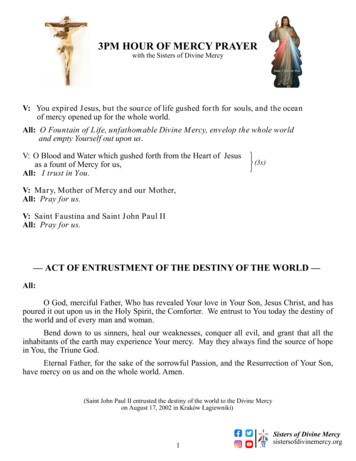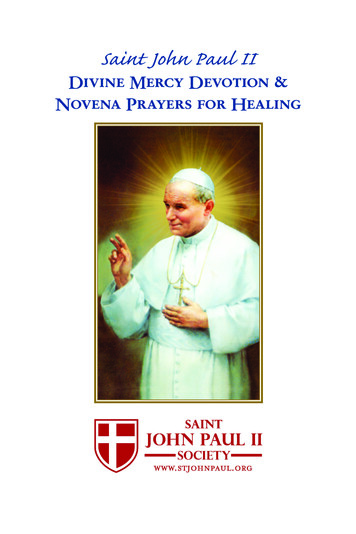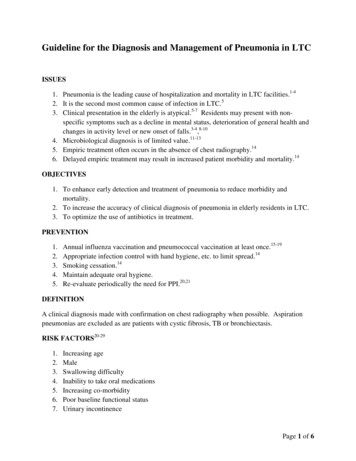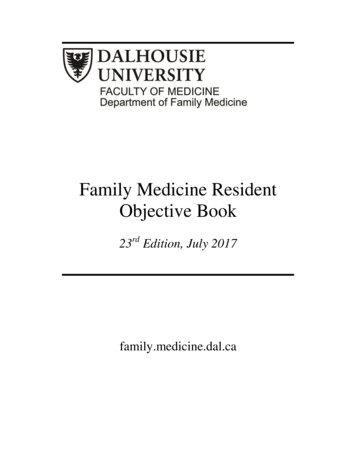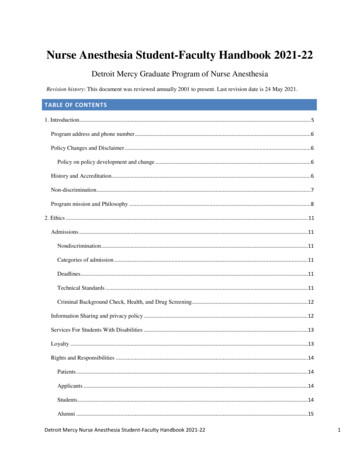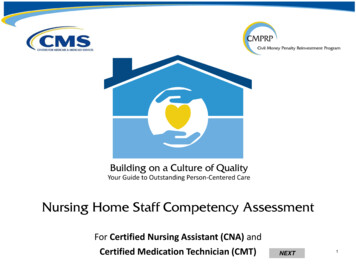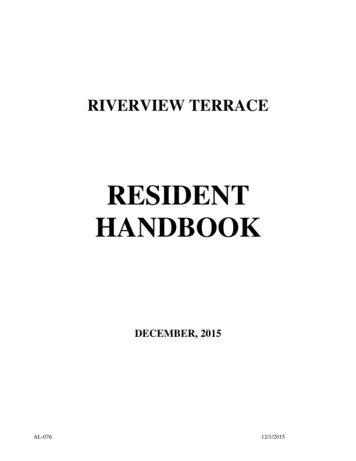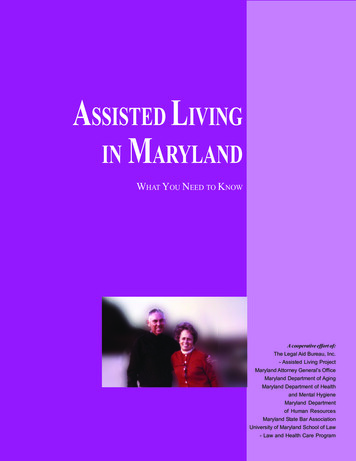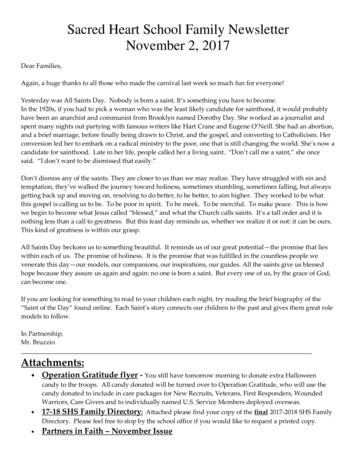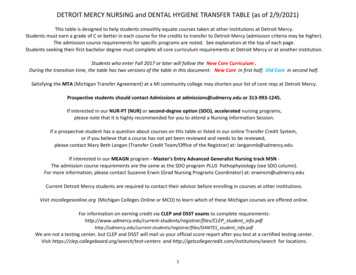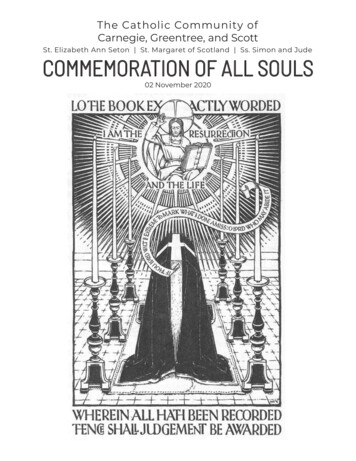
Transcription
Resident HandbookMercy Redding Family PracticeResidency Program2017-20181
Resident HandbookMercy Redding Family Practice Residency Program2017-2018I. WELCOME . 7RESIDENCY MISSION .7OUR PARTNERSHIP IN LEARNING . 8INSTITUTION MISSION STATEMENT, VISION, CORE VALUES .9STATEMENT OF COMMITMENT TO RESIDENCY PROGRAM .9CURRICULUM . 13CURRICULUM RESOURCES . 13II. CLINICAL ROTATIONS AND EXPERIENCES . 13ADVANCED LIFE SUPPORT TRAINING (PGY1, PGY2, PGY3). 13BEHAVIORAL SCIENCE (PGY1, PGY2, PGY3) . 14CARDIOLOGY (PGY1, PGY2, PGY3) . 16CLINIC I and CLINIC II ROTATIONS (PGY2, PGY3) . 18COMMUNITY MEDICINE (PGY1) . 26CONTINUITY HOME CARE VISITS (PGY2, PGY3) . 28ENT (PGY3) . 30ELECTIVES (PGY2, PGY3) . 31EMERGENCY MEDICINE (PGY1, PGY2, PGY3) . 34THE FAMILY PRACTICE CENTER . 41FAMILY PRACTICE SERVICE (Inpatient/Outpatient Rotation) (PGY1) . 41GYNECOLOGY (PGY2, PGY3). 44INTENSIVE CARE UNIT (PGY1, PGY2, PGY3) . 45INTERNAL MEDICINE SERVICE (PGY1, PGY2, PGY3) . 47INTERNAL MEDICINE-NIGHT SHIFT (PGY1, PGY2, PGY3) . 522
PEDIATRICS/OB (PGY1, PGY2, PGY3) . 54OPHTHALMOLOGY (PGY3). 61ORIENTATION . 62ORTHOPEDICS / SPORTS MEDICINE (PGY1, PGY2, PGY3) . 63PEDIATRIC OUTPATIENT ROTATION (PGY2) . 65MANAGEMENT OF HEALTH SYSTEMS (PGY1, PGY2, PGY3) . 66RADIOLOGY, LAB, ABFM ROTATION (PGY2) . 72SCHOLARLY ACTIVITY AND RESIDENT PRESENTATIONS (PGY1, PGY2, PGY3) . 75RURAL FAMILY MEDICINE (PGY2) . 78SURGERY ROTATION (PGY1, PGY3) . 79URGENT CARE . 80UROLOGY (PGY3) . 81III. POLICIES AND PROCEDURES. 83ACADEMIC COUNSELING: . 83ADMITTING PROCEDURES: . 84ADMISSION STATUS. 85ADVANCE DIRECTIVES & RESUSCITATION STATUS:. 85APPEARANCE: . 85ANNUAL PROGRAM EVALUATION (APE) AND PROGRAM EVALUATION COMMITTEE . 85AUTOPSIES: . 86BALINT GROUP/ RESIDENT WELLNESS/ INTERN CONFERENCE: . 87BOARD CERTIFICATION: . 90CHIEF RESIDENTS: . 91CLINICAL COMPETENCY COMMITTEE . 91CONFERENCES: . 93CONTINUITY POLICY . 94COUNTERSIGNATURE REQUIREMENTS FOR RESIDENT CHARTS: . 953
CONSENTS AND RELATED MATTERS: . 95CRITERIA FOR ADVANCEMENT/PROMOTION OF RESIDENTS IN FAMILY PRACTICE: . 95DEATH RELATED ISSUES: . 97DOCUMENTATION OF RESIDENCY EXPERIENCE: . 98DUE PROCESS PROCEDURE FOR RESIDENCY PROGRAM . 98EVALUATIONS:. 101FAMILY OR FRIENDS VISITING RESIDENTS AT HOSPITAL: . 104FNP/PA STUDENTS: . 104GRADUATE MEDICAL EDUCATION COMMITTEE . 104GRIEVANCES AND COMPLAINTS: . 106INTERN ORIENTATION CHECKLIST (In-Patient) . 107IN-TRAINING EXAMINATION . 109LEAVE POLICIES: . 110LEAVING THE HOSPITAL AGAINST MEDICAL ADVICE (AMA): . 110LEGAL ISSUES . 110LICENSURE: . 110MAIL AND MESSAGES: . 111MALPRACTICE: . 111MEDICAL RECORDS: . 111MEDICAL STAFF BYLAWS / RULES AND REGULATIONS OF THE MEDICAL STAFF . 112MEDICAL STUDENTS:. 112MEDICAL STUDENTS APPLYING TO RESIDENCY–CRITERIA . 112MERCY MEDICAL CENTER PERSONNEL POLICIES: . 114MOONLIGHTING POLICY: . 115OTHER RESIDENT/EMPLOYEE BENEFITS: . 116PAID TIME OFF (PTO):. 116PERSONAL DAYS. 117PRESCRIPTIONS: . 1174
PROCEDURE COMPETENCY . 119PROFESSIONALISM . 122PSYCHIATRIC TEMPORARY CUSTODY (5150): . 126REPORTABLE CASES:. 126RESIDENT IMPROVEMENT PLANS AND RESIDENT CONFIDENTIALITY . 127SCHEDULES, CALL, and SIGN-OUT . 127MASTER SCHEDULE: . 131SENTINAL EVENTS . 132SICK LEAVE. 133SUPERVISION:. 133VENDOR POLICIES . 138WORK HOURS . 138IV: ADDENDUM: MERCY FAMILY HEALTH CENTER CLINIC MANUAL . 140THE FAMILY PRACTICE CENTER . 140OFFICE ADMINISTRATIVE STAFF . 140CORE FACULTY . 141I. CLINIC SCHEDULE AND TIMES . 141GENERAL GUIDELINES . 142II. CLINICAL AREAS. 142CLIA OUTPATIENT LABORATORY PROFICIENCY TESTING . 142CLINIC I and CLINIC II ROTATIONS . 143WARFARIN PROTOCOL . 143DUTIES OF THE C1 CLINIC DOCTOR . 149SPECIALTY CLINICS . 151SPECIALTY CLINICS . 152CLINIC REFERENCE BOOKS AND ONLINE RESOURCES . 154CONTINUITY OBSTETRICS EXPERIENCE . 1545
MISSION PROVIDER SERVICES . 158NEWBORN CARE . 159OSTEOPATHIC MANIPULATION THERAPY . 159PRACTICE MANAGEMENT . 160PROCEDURE REQUIREMENTS AT MFHC. 160SKILLED NURSING FACILITY VISITS . 161III. POLICIES AND PROCEDURES . 161ADMISSIONS AND CONTINUITY OF PATIENT CARE . 161APPEARANCE . 161BILLING AND DOCUMENTATION . 161EVALUATIONS . 161GRIEVANCES AND COMPLAINTS . 162HOLIDAYS AND VACATIONS . 162MEDICAL STUDENTS . 163NURSING ORDERS . 165PAP TEST WITHOUT ENDOCERVICAL CELLS . 165PATIENT DELIVERED PARTNER THERAPY . 167PHONE MESSAGES AND RESPECTING PRIVACY - HIPAA . 167PHONE CALLS FROM HOSPITAL OPERATOR AFTER HOURS . 168PRESCRIPTIONS . 170PRODUCTIVITY AND PATIENT PANELS . 173REFERRAL PROTOCOL . 173REPORTABLE CASES . 174SURGICAL ASSISTING POLICY . 175SUPERVISION REQUIREMENTS FOR MEDI-CAL . 1756
Resident HandbookMercy Redding Family Practice Residency ProgramI. WelcomeOur Educational Philosophy:We recognize our family practice residents as adult learners who will achieveclinical competence through an evidence based competency directed experience.We are committed to providing appropriate clinical experiences and effectivesupervision and teaching to achieve the highest level of competency.RESIDENCY MISSIONIs threefold: to graduate family physicians who are highly qualified to practice inrural and suburban areas, to provide care to the medically underserved in ourcommunity (especially in rural settings), and to further the science and practice offamily medicine through the application of Information Technology andManagement.At its inception in 1975, the Family Practice Residency Program was based at the Shasta GeneralHospital in Redding, California. The program began with the mission to produce well-trainedfamily physicians to enter practice in the surrounding region. Our graduates have met many ofthose needs, especially as the population has grown, but there remain substantial, under-servedpopulations in the north state in need of basic primary care services. A fundamental goal of thisresidency is to meet these needs, while advancing the practice of health promotion and diseaseprevention in the community.In February of 1988, Shasta General Hospital closed. Through the efforts of many, but perhapsmost notably the resident staff, sponsorship of the residency program was transferred to MercyMedical Center, Redding. With our new hospital partner, the underlying residency mission toaddress the unmet health needs of the north state, through training qualified family physicianswas reaffirmed. The Sisters of Mercy, and parent organization Dignity Health, sponsor thisresidency program as a tangible effort to meet the needs of the poor and under-served in ourcommunity. We welcome you to share this mission.In your role as a family physician in training, you will be called upon, in widely varied and oftenchallenging circumstances, to provide competent and compassionate care to others. With thesupport of your fellow residents, the residency faculty, the hospital and community, you willfurther your confidence and skills as a physician. We challenge you to take a broad perspectiveof your developing role as a family physician. You have entered training as a generalist, butbeyond that, the community in which you practice will need you as a community physician. Useyour time with us to enhance your understanding of, and effectiveness in, working with the7
community you serve. In doing so, you will truly reach your potential to positively impact thelives of your patients.While becoming a family physician, we do not expect you to sacrifice your life outside ofresidency. Family Practice training can be a demanding task, yet truly effective family doctorshave learned to balance their personal needs for fulfillment with the demands of their job. Whileshort-term compromises must be made, our goal is to support a healthy personal, family andemotional lifestyle during residency that you will carry into practice. You will only be effectiveand satisfied as a family physician to the degree that you can find balance and fulfillment in themany roles you play.Your time in residency training will be divided between the Family Practice Center, MercyMedical Center, and community based opportunities. The majority of PGY1 clinical rotationsare spent at Mercy Medical Center where you'll learn to function effectively in the in-patientenvironment. As you progress through your residency training, an increasing proportion of yourtime will be focused on the Family Practice Center and ambulatory rotations. Each week in thecenter you will build relationships with a growing panel of your own patients. Your patients willlook to you for ongoing care and advice. Through these relationships you will learn to be apersonal physician. Try to stop by the center every day if possible, to keep up with patientmessages, prescription refill requests, etc. You'll know your patients better, be more help to theclinic staff, and everyone will get more satisfaction out of the relationship. Following yourpatients when they are hospitalized or when they deliver an infant is part of your education aswell. While this can be a challenge at times, continuity of care is a foundation of family practice.The family practice center is also actively involved in the training of primary care associatessuch as Family Nurse Practitioners and Physician's Assistants. This association of residentphysicians and primary care associates gives you the opportunity to learn to function as a teammember in an interdisciplinary approach to health care. Take advantage of it as the skills tofunction effectively as a team member/leader will likely be essential to your success as a modernphysician.The faculty is here to support you in your clinical care and professional growth. FamilyPhysicians from the community (many of whom are program graduates) share the time as familypractice preceptors as well. Many other physicians are actively involved in the Family PracticeResidency Program as preceptors, guest lecturers and consultants. We welcome you to ourcommunity, look forward to working with you, and hope your experience offers both challengeand achievement.OUR PARTNERSHIP IN LEARNINGLearning and teaching represents a partnership that is dynamic and challenging. Every personhas their own background experiences, their “best” way to learn, and their “style” of teaching.At one moment the resident may be the learner, and at the next the teacher. Different teachersmay have very different (and equally successful) methods for managing a particular clinical8
problem. As a result, clear communication on needs and expectations will help the process alongsubstantially. The full time and volunteer faculty teach because they want to, and the residentsare here to develop in three short years the skills necessary to launch a successful career.INSTITUION MISSION STATEMENT, VISION, CORE VALUESSTATEMENT OF COMMITMENT TO RESIDENCY PROGRAM9
10
11
12
CURRICULUMCURRICULUM RESOURCESThe residency program has a variety of educational resources including the hospital library(journals and textbooks), Mercy Family Health Center library (outpatient oriented textbooks),UpToDate on-line, and Clinical Key on-line (textbooks, journals, and multimedia). Theresidency program also subscribes to Family Medicine Residency Curriculum Resource whichcan be accessed at www.fammedrcr.com using the residency password.II. Clinical Rotations and ExperiencesADVANCED LIFE SUPPORT TRAINING (PGY1, PGY2, PGY3)Core CompetenciesAt the completion of residency training, a family medicine resident should:13
Demonstrate an ability to rapidly assess and gather information pertinent to the care ofpatients in an urgent and emergent situation and develop treatment plans appropriate tothe stabilization and disposition of these patients. (Patient Care, Medical Knowledge)Be able to identify the indication and perform procedures appropriately for thestabilization of the patient in an urgent and emergent care setting. (Patient Care, MedicalKnowledge, Practice-based Learning and Improvement)Acquire the requisite skills in appropriate utilization of the resources available in theurgent and emergent care setting, including laboratory, radiology, ancillary services, andconsultations with specialists (including transfer to a higher level of care). (Systemsbased Practice)Demonstrate an ability to learn from experience, perform self-analysis of practicepatterns, and participate in peer review of practice patterns. (Practice-based Learning andImprovement)Appropriately inform, educate, and elicit patient and family participation in medicaldecision making in a professional and caring manner with sensitivity to cultural andethnic diversity. (Professionalism, Interpersonal and Communication Skills)Residents are required to maintain certification in NRP and PALS, CardiopulmonaryResuscitation (Basic Life Support) and Advanced Cardiac Life Support (ACLS) all of which arecompleted during orientation. Re-certifications are required at the end of the R-2 year and canbe taken at Mercy (Plan ahead for this). Advanced Trauma Life Support (ATLS) is an excellentintensive course, which is required for any resident who is licensed and who wishes to moonlightat a rural/remote ED in California. ATLS courses are available but often hard to schedule, soplanning ahead is very important. The residency program will pay for the course registration,but all other costs are the resident’s. Finally, ALSO courses are provided through the UC DavisNetwork, and all residents are encouraged to attend. Beginning in 2011, all PGY1 residents willbe required to attend.BEHAVIORAL SCIENCE (PGY1, PGY2, PGY3)A. Core CompetenciesAt the completion of residency training, a family medicine resident should: Understand normal and abnormal psychosocial growth and development acrossthe life cycle and be able to apply this knowledge to the care of the individualpatient. (Medical Knowledge, Patient Care)Be able to recognize, initiate treatment for, and utilize appropriate referrals formental health disorders to optimize patient care. (Systems-based Practice, Practicebased Learning and Improvement)Demonstrate the ability to effectively interview and evaluate patients for mentalhealth disorders using appropriate techniques and skills to enhance the doctorpatient relationship. (Interpersonal and Communication Skills, Patient Care)Have sensitivity to and knowledge of the emotional aspects of organic illness.(Patient Care, Professionalism)14
Be able to intervene effectively and professionally in emergent psychiatric,domestic violence, child abuse, and disaster situations. (Professionalism, Systemsbased Practice)Understand the impact of mental health disorders on the family unit.B. Service GoalsThe primary objective of the Behavioral Science Curriculum is to help Family Practice Residentsmore fully develop the skills and the knowledge base needed to intervene meaningfully andefficiently in the mental health issues of patients. A large percentage of patients seekingambulatory care have a psychosocial or cultural issue of significance that if unrecognized ormismanaged seriously impairs the effectiveness of the physician’s care. Residents are expectedto achieve the full set of Behavioral Science and Psychiatry Competencies through thiscurriculum. Curricular resources and reading material can be accessed on the Family MedicineResidency Curriculum Resource at www.fammedrcr.com .C. Service DescriptionA two-week rotation occurs in the first year, and includes a variety of elements ofbehavioral medicine, psychiatry and psychopharmacology. Two half-days per month areallocated for to an ongoing “special clinic” devoted to psychiatry which occursthroughout the year and residents will rotate individually through this clinic at the MercyFamily Health Center (viz., FPC). In addition to the specific first year curriculum and thespecial clinic, behavioral science is i
Jun 18, 2015 · family medicine through the application of Information Technology and Management. At its inception in 1975, the Family Practice Residency Program was based at the Shasta General Hospital in Redding, California. The program began with the mission to produce well-trained family
